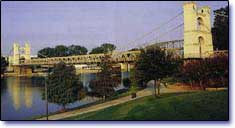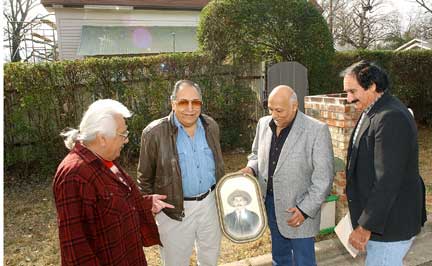

Places in Time
Places in Time: I-35 | See entire Tribune-Herald series on I-35

Why was old Waco neighborhood called 'White City'?
By Terri Jo Ryan, Tribune-Herald
March 24, 2006
The mystery of why a segment of Waco close to the traffic circle was named "White City" is slowly being solved with the help of the people who once lived there.
More than 50 former residents came to the Cen-Tex Hispanic Chamber of Commerce building on La Salle Avenue to share their stories of the "suburb" formed in the early 20th century and which flourished until it was bisected by Interstate 35's construction in the mid-1960s.
John Young, opinion page editor of the Tribune-Herald and a leader
of the Waco History Project, posed the question to residents how the suburb came by its name.
Young admitted that some conjecture was that the name had a racial connotation. But the black and Hispanic families, as well as the handful of Anglos who sunk roots there, demonstrated that was not the case.
"You are the experts on local history here," Young told the former residents. "This is the kind of history you can't find in a book."
Some residents like Joe Gutierrez said the name came from the neat rows of white houses, and the trees which were painted white with an insect-fighting coating.
But Armando Reyes, whose parents bought their home at 2318 Bagby Ave. in 1933, said that he saw paperwork from the Waco Abstract and Title Company that indicated the area was named for the original developer, a Mr. White. This man was also likely the owner of the old White City Grocery, he added.
The property of his old family homestead now abuts the access road for I-35, Reyes added.
Other residents helped Robert Gamboa, a local history compiler who grew up in the predominantly Hispanic part of Waco known as Sandtown, come up with rough boundaries for White City. The boundaries were based on their memories of grocery stores, convenience stores, feed stores, taverns and restaurants, even a malt shop/juke joint for teenagers.
The Hispanic portion of White City was formed in the triangle of Valley Mills Drive, Circle Drive and Speight Avenue. The black portion was found east of Circle Drive for several blocks down La Salle Avenue.
Carlota Garcia-Herrera, a Bellmead native born in 1930, said her family lived in White City from 1935-1940, when they moved to South 10th Street.
During her time there, she said, she started school at South Waco Elementary School, walking several blocks in one direction, while her black neighbors' children walked many more blocks in the opposite direction to get to their school.
Known as South Waco Negro School and located at South Ninth Street and Oakwood Avenue, close to the cemetery, the segregated elementary school meant a perilous path across busy La Salle Avenue until a pedestrian tunnel was eventually put in for black children, recalled civil rights activist Jewel Lockridge, who grew up in White City on Wood Avenue.
"All my memories of White City are good memories," said Herrera, who cherished living only a block away from her grandmother, Locaria Hernandez. "You knew your neighbors, and we shared and took care of each other. Not like nowadays when you don't even know your neighbors and have to keep your doors locked at all times."